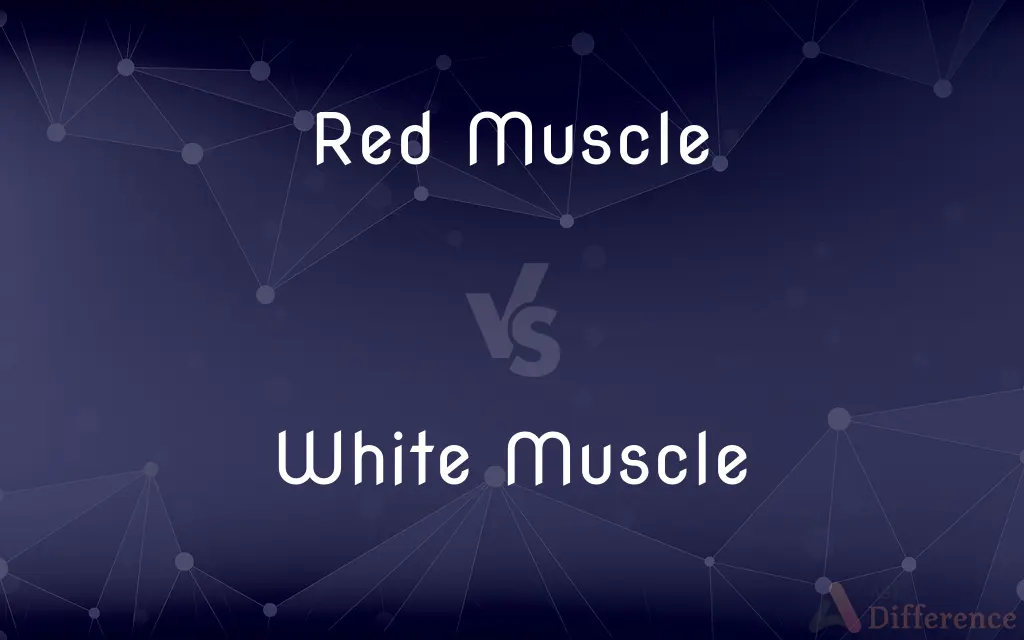Red Muscle vs. White Muscle — What's the Difference?
By Urooj Arif & Maham Liaqat — Published on March 27, 2024
Red muscle fibers are rich in mitochondria and oxygen, supporting endurance, while white muscle fibers are less vascularized, suited for quick, powerful bursts.

Difference Between Red Muscle and White Muscle
Table of Contents
ADVERTISEMENT
Key Differences
Red muscle fibers, known for their high myoglobin content and rich blood supply, are designed for endurance and sustained activity. They contain a large number of mitochondria, enabling aerobic respiration and allowing these muscles to work for extended periods without fatigue. On the other hand, white muscle fibers are characterized by a lower myoglobin content and fewer mitochondria, which supports short bursts of high-intensity activity but leads to quicker fatigue due to their reliance on anaerobic metabolism.
While red muscle fibers are efficient at using oxygen to produce energy, making them ideal for activities like long-distance running or swimming, white muscle fibers generate energy more quickly but less efficiently, making them better suited for sprinting or lifting heavy weights. This difference in energy production also means that red muscles can sustain activity for longer before tiring, whereas white muscles are more prone to fatigue.
The distribution of red and white muscle fibers varies among different species and is also influenced by genetics and training. Animals that are adapted to endurance activities, such as deer or migratory birds, tend to have a higher proportion of red muscle fibers. Conversely, animals requiring quick bursts of speed, like cheetahs, have a higher proportion of white muscle fibers. In humans, the ratio of red to white muscle fibers can be influenced by both genetics and the type of physical training one engages in.
Red muscle fibers are also known for their ability to recover quickly from exertion, thanks to their enhanced blood supply and aerobic metabolism. This rapid recovery allows for frequent and prolonged activities without significant loss of performance. White muscle fibers, however, recover more slowly due to the accumulation of lactate from anaerobic metabolism, which can lead to muscle soreness and fatigue.
The color difference between red and white muscle fibers is primarily due to the presence of myoglobin, an oxygen-binding protein, in red fibers. Myoglobin facilitates the transport and storage of oxygen within muscle cells, contributing to the reddish hue of these muscles. White muscle fibers have much less myoglobin, which is why they appear lighter or white.
ADVERTISEMENT
Comparison Chart
Primary Energy Source
Aerobic respiration
Anaerobic metabolism
Myoglobin Content
High
Low
Mitochondria Density
High
Low
Function
Endurance activities
Quick, powerful bursts
Fatigue Resistance
High
Low
Compare with Definitions
Red Muscle
Adapted for prolonged activity without fatigue.
Red muscles power the continuous swimming of fish.
White Muscle
Generates energy quickly but inefficiently.
White muscle fibers are engaged during explosive jumps.
Red Muscle
Utilizes oxygen for energy, making it highly efficient.
Red muscle fibers are crucial for endurance sports.
White Muscle
Suited for short, intense activities.
White muscles are predominant in sprinters.
Red Muscle
Supports sustained, aerobic activities.
Red muscles are essential for marathon runners.
White Muscle
Relies on anaerobic metabolism for energy.
Weight lifting relies heavily on white muscle fibers.
Red Muscle
Quick recovery due to aerobic metabolism.
Athletes with more red muscle fibers recover faster between sessions.
White Muscle
Provides quick bursts of speed and strength.
Predators use white muscles for rapid strikes.
Red Muscle
Enables efficient energy production.
Birds' flight muscles predominantly consist of red fibers for long distances.
White Muscle
Prone to quick fatigue due to lactate buildup.
High-intensity training can lead to soreness in white fibers.
Common Curiosities
Why do red muscles not fatigue as quickly as white muscles?
Red muscles utilize aerobic respiration, which is more efficient and produces less lactate, reducing fatigue.
Why are white muscle fibers more prone to fatigue?
They rely on anaerobic metabolism, which quickly depletes energy reserves and accumulates lactate, leading to fatigue.
What distinguishes red muscle fibers from white muscle fibers?
Red muscle fibers are adapted for endurance, with high myoglobin and mitochondria, while white muscle fibers are suited for short, intense bursts due to their lower myoglobin content and reliance on anaerobic metabolism.
How does the distribution of muscle fiber types affect athletic performance?
Athletes with more red fibers excel in endurance sports, while those with more white fibers perform better in sprinting and strength disciplines.
Can the proportion of red and white muscle fibers in a body change?
Yes, through specific training, the characteristics of muscle fibers can adapt, influencing their proportion and function.
What impact does aerobic training have on muscle fiber composition?
Aerobic training can enhance the endurance capabilities of muscle fibers, potentially increasing the proportion of red fibers.
What role does myoglobin play in muscle fibers?
Myoglobin stores and transports oxygen within muscle cells, supporting the aerobic metabolism of red muscle fibers.
How do white muscle fibers generate energy?
Through anaerobic metabolism, which provides quick energy but is less efficient and leads to faster fatigue.
Do all animals have the same ratio of red to white muscle fibers?
No, the ratio varies significantly among species and is adapted to their lifestyle and environmental needs.
Can training convert white muscle fibers into red fibers?
Training can induce changes that make fibers function more like the opposite type, but a complete conversion is not typical.
What is the significance of the high mitochondrial content in red muscle fibers?
It allows for efficient energy production through aerobic respiration, supporting sustained activity.
Is it possible to increase the density of mitochondria in muscle fibers?
Yes, aerobic exercise can increase mitochondrial density, especially in red muscle fibers, enhancing endurance.
How does myoglobin contribute to the color of muscle fibers?
Myoglobin's presence gives red muscle fibers their characteristic color, while its absence in white fibers results in a lighter appearance.
Why do some sports favor athletes with a higher proportion of red muscle fibers?
Endurance sports, like long-distance running, benefit from the efficiency and fatigue resistance of red muscle fibers.
Why are red muscle fibers more efficient at using oxygen?
Their high myoglobin content and abundance of mitochondria facilitate the efficient use of oxygen for energy production, enhancing endurance.
Share Your Discovery

Previous Comparison
Thermal Coal vs. Metallurgical Coal
Next Comparison
Mozzarella vs. ProvoloneAuthor Spotlight
Written by
Urooj ArifUrooj is a skilled content writer at Ask Difference, known for her exceptional ability to simplify complex topics into engaging and informative content. With a passion for research and a flair for clear, concise writing, she consistently delivers articles that resonate with our diverse audience.
Co-written by
Maham Liaqat















































